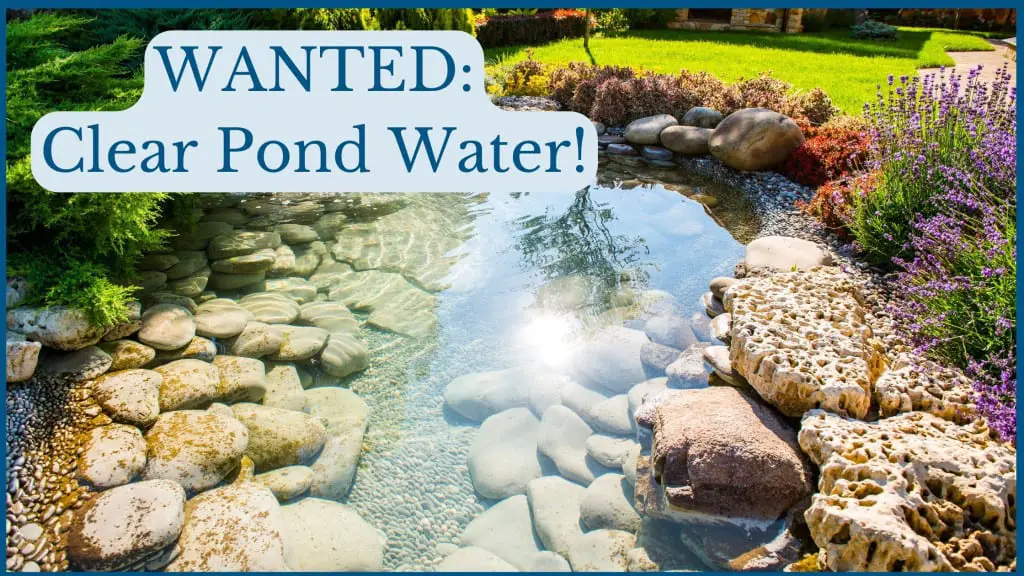May I assume that you are annoyed by the look (or even the smell) of the water in your pond? Your water is far from crystal clear, and your fish are suffering. You probably searched the internet for some clear instructions, but unfortunately, the topic of water quality is a bit of a challenge. If this describes your predicament, then this article is for you.
In this article, I discuss the topic of pond water quality management in logical steps, starting with the reason why your pond water is not clear (excess nutrients) and what you can do about it (a lot). Once you understand the underlying issues and how the different measures deal with them, you will succeed in curing the quality of your pond water once and for all. Feel free to skip ahead to the section most relevant to you, but we recommend that you take some time and read it in full.
What’s Inside:
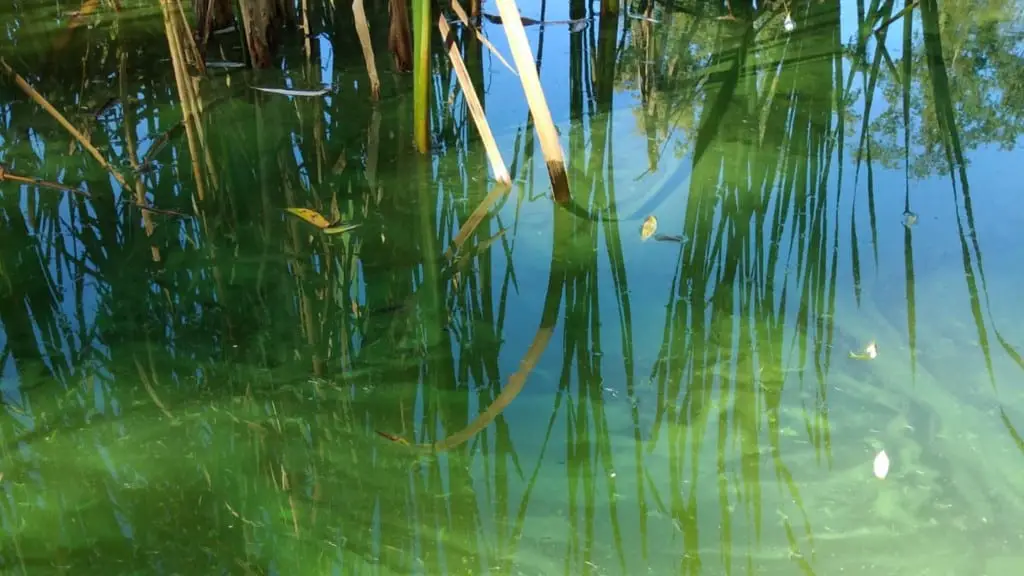
Why your pond water is not clear
If your pond water is murky with one of a variety of colors ranging from green, brown, red, blueish, yellow/gold, or any color in between, this is almost always caused by excess growth of algae. It is a sign that the ecological balance of your pond is out of kilter.
Algae is a common name for thousands of photosynthetic organisms that range from single cellular species to large plant like structures in the form of filaments or mats (but they are not plants though because they have neither a root system, a stem, nor leaves). Algae are an essential part of a healthy and natural freshwater or marine aquatic ecosystem.
The growth of algae is conditioned by the availability of just three things: nutrients, temperature, and light. The nutrients for algae are substances that contain carbon, nitrogen and phosphorus which are found in wastewater, artificial fertilizers, manure and in many foods including vegetables, dairy products, meat, and grains.
The excess nutrient availability in your pond may be caused by inflow from groundwater, from occasional stormwater, or within the pond by organic matter from decaying leaves, algae and fish waste exacerbated by overfeeding the fish or other animals in your pond.
If there is excess nutrient availability in your pond, the growth of algae will spiral out of control during the summer months because of the warm temperature and long sunshine hours. During the day, algae (and aquatic plants) use nutrients to grow and produce oxygen through photosynthesis. So far, so good.
However, during the night, photosynthesis can’t continue, and algae (and plants) will use oxygen dissolved in the water to stay alive. If there are too many algae in a pond, they will use up all the oxygen in the pond water, which will cause plants, fish, and even the algae to suffer and die, which will increase the amount of nutrients in your pond, and so on.
This process is known as an algae bloom, which may also cause an increase of the water’s pH and toxic unionized ammonia and nitrite (which are, like nitrate, different forms of nitrogen). The algae bloom will disappear when the temperature drops in late summer.
In conclusion, an algae bloom is caused by an excess of nutrients and may cause your fish to die from heat stress, lack of oxygen, or poisoning.
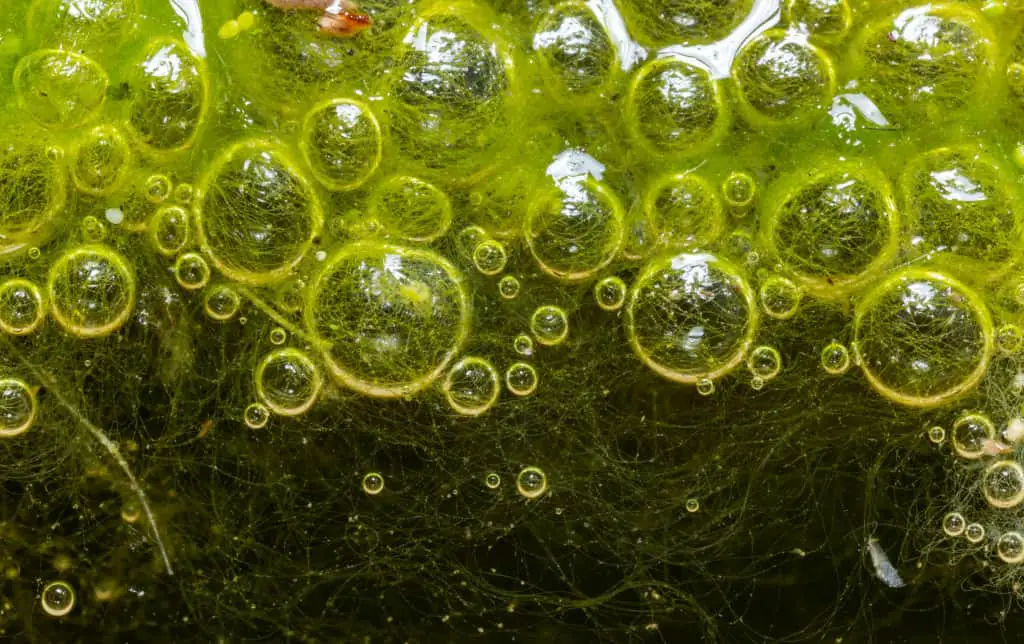
Here’s How to make and keep your pond water clear:
Actions to reduce the nutrient level in the pond water
The most natural way to prevent such a disaster is to lower the availability of nutrients in your pond and restore an ecological balance. This can be done by one or all the following actions:
- Preventing the inflow of nutrient-rich surface water runoff or groundwater.
- Reduce the amount of food needed for your fish or waterfowl to the essential quantity. It is also essential that the food floats long enough to be eaten before it sinks and adds to the nutrient store at the bottom of the pond.
- by introducing plants in the pond that take up nutrients and provide shade thus lowering the light intensity. You may also opt for fast growing plants like water lettuce that you can easily take out of the pond and dispose off as compost for your garden. Duckweed falls also in this category but tends to be difficult to control so if you do not have duckweed, you better keep it that way because it will keep you busy.
- by reducing the number of fish or other animals that you keep in the pond.
- By draining nutrient rich pond water and filling up with nutrient poor fresh water. The preferred option is to use clean harvested rainwater and strictly avoid the direct application of chlorinated municipal water. If municipal water is your only option, let it stand outside in an open container for at least a day before you add the water to the pond.
- by operating a biofilter that hosts bacteria that break down ammonia (toxic to fish) into nitrates which is a source of food for pond plants. The biofilter requires a pump and is typically preceded by a skimmer and a mechanical filter.
- by operating a skimmer and a mechanical filter that capture floating debris off the water surface before it can sink to the bottom of the pond and add to the nutrient supply. A skimmer/fiter requires a pump.
- By cleaning the pond bottom with a vacuum. This takes away the organic waste at the bottom of the pond. If your pond is sealed with a liner, you must be exceedingly careful with pond bottom cleaners and not even think of dredging the pond bottom. MuckSuckers claims to offer a pond cleaning system that does not destroy pond liners.
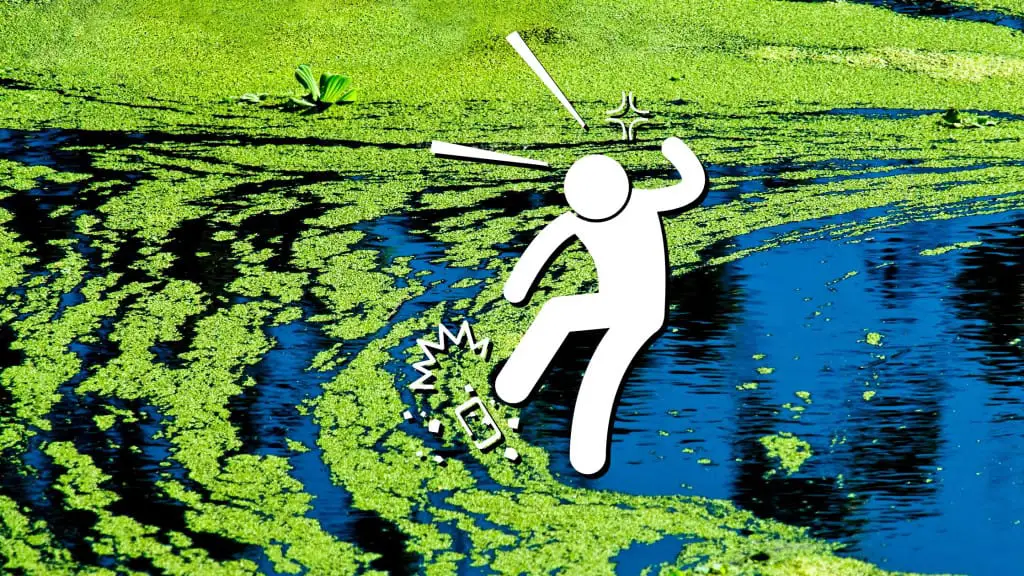
Actions to destroy the algae
A complementary approach is to remove the algae. However, if you do not reduce the nutrients by any of the methods under the previous heading, you do not really solve the problem. Nevertheless, algae can be reduced by any or all the following methods:
- raising fish and other creatures that feed on algae (koi, goldfish, grass carp, pond loach, several types of catfish, shrimps, snails, and tadpoles). It is possible to introduce a lot of species that help reduce the algae problem and support the ecological balance. This solution does not solve the problem when your pond is heavily infested with algae.
- UV light. Certain types of UV light damage the DNA of bacteria and other microorganisms like viruses and algae. This action is often combined with a mixed mechanical/biological filter. For a mechanical filter to effectively retain algae, it would need a filtration size of less than a micron (a thousandth of a millimeter) which is not very practical for pond filtration. An UV light does not solve the problem when your pond is heavily infested with algae and for a well-balanced pond, there is no need to eradicate all algae, just let nature do its work.
- Biological treatment. These are products that propose a proprietary concoction of natural “good” bacteria and associated agents (enzymes), that aims to reduce the algae population. Algae and bacteria have extremely complex interactions between their innumerable species, and I do not doubt that the introduction of selected bacteria species may reduce algae. The main issue I see, is that many bacteria require oxygen to do their deeds. We consequently suggest raising the oxygen content of the pond before any biological treatment is considered. If any lack of oxygen is corrected, it seems likely that nature will do its work with or without biological treatment and a starter dose may be helpful to accelerate the process. However, when a seller proposes repeat treatments, I am not convinced that this is the right approach. The supply of oxygen is discussed in the next paragraph.
- Ultrasound treatment. This is another method that has been around for some time. This is an amplifier system that produces sound waves in the water at (for us humans) inaudible frequencies of 20k Hertz and above. The most plausible claim is that these sound waves interfere with the gas vacuole of the algae. The gas vacuole is a sort of floating device that helps algae to find their place near the sun during the day and night cycle. If the vacuole is damaged the algae can no longer float and will die. There are multiple (large) ponds and lakes where this approach is reported to be effective but keep in mind that an ultrasound treatment does nothing against the issue of excess nutrients in the pond system.

Actions to boost dissolved oxygen level in the pond water
Remember that we talked about the lack of oxygen induced by the algae bloom? When installing an aerator, a waterfall, or a fountain each with adequate capacity, we provide oxygen to the pond.
In short, if we provide more oxygen than would be needed for digesting the amount of nutrients sunk in the pond, we still reduce the nutrient level. Digesting is what bacteria do with nutrients in a pond (or, indeed, in your gut). A more detailed explanation of pond digestion is found at the end of this article.
For aerators, there is a choice between an air diffuser, which introduces air at the bottom of the pond, and surface aerators that agitate the water at the pond surface. A properly dimensioned and installed air diffuser is by far the most effective method between the two options (both energy wise and result wise) because they lift bottom water to the surface thus mixing dissolved oxygen as well as warm surface and cool bottom layers (during the summer).
Surface aerators or agitators pump and spray a mixture of water and air at the surface layer of the pond but do not do much to improve the oxygen content at the bottom of the pond.
A fountain or a waterfall has the same limitation in that there is inadequate exchange between oxygen-rich water at the surface and oxygen-poor water at the bottom of the pond. This is not overly problematic if you have a shallow pond (less then 4 or 5 feet), but if you have a deeper pond, an air diffuser should be your preferred option.
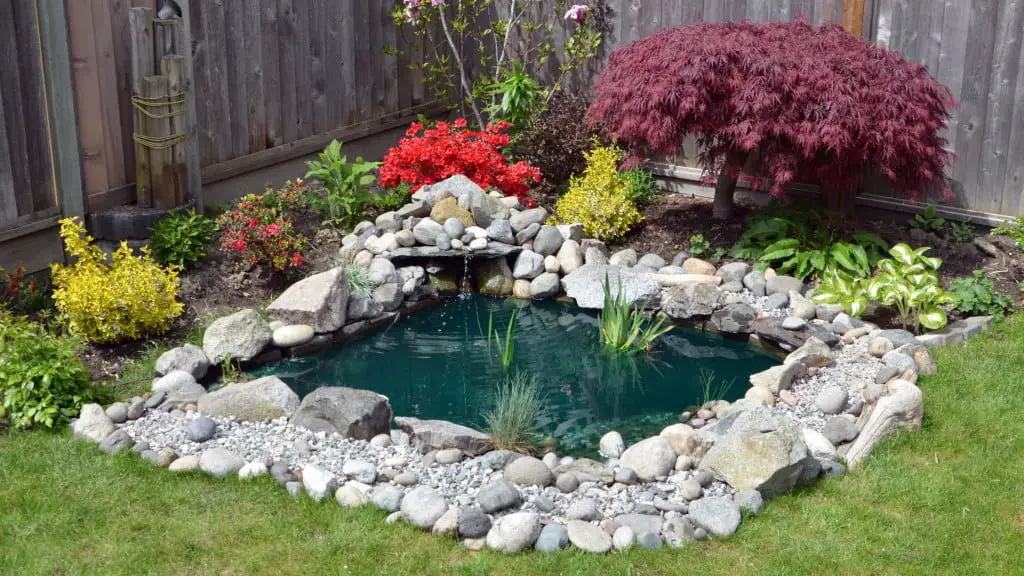
Wrap-up
In conclusion, if your pond suffers from algae blooms during summer, the root cause it the high nutrient level. You need to investigate how this high nutrient level in your pond came about:
- Is it from the initial water supply? If so, change the water or treat it.
- Is it from continuous or occasional ground- or surface water inflow? If so, prevent further inflow from these sources or treat the pond water after every inflow.
- Is the balance between fish and plants the problem? If so, improve the balance between fish and plants, particularly fast-growing plants that provide shade, and fish that eat algae. If you have too many fish in your pond and you do not want to reduce, you will have to improve your treatment systems as otherwise nature will take care of business for you.
- Could it be that you supply too much food for the pond dwelling animals? If so, reduce the amount of food in accordance with their rate of metabolism and the seasonal temperatures.
- Is there a lot of muck at the bottom of the pond? If so, the treatment system is not adequate for the quantity of nutrients passing through the pond ecosystem.
If you have recurrent algae problem and you do not find a clear cause from the questions above, the treatment system of your pond is not adequate, and you should increase the combined capacity of your treatment methods. Use any of the low-cost activities suggested (prevent uncontrolled inflow, reduce fish and fowl, increase plants (unless you already have a lot), and reduce food supply to essential needs).
If you have a treatment system check if the capacity is sufficient. The flow should be enough to circulate the pond volume in about 2 hours (or less if you have a lot of fish). For medium to large ponds, you may check if the intake and return flow are at opposing sides to favor water circulation. If you start running your treatment system only in summer for a few hours a day when you observe the water less transparent and colored, start operating it 24/7 and year-round.
If you have a shallow pond and your water treatment system consists of just a fountain and/or a waterfall, see if you can enhance it with a biofiltration system.
If your pond is deeper than 6 feet, see if you can install an air diffuser as this is likely to be effective for a moderate investment and low operating costs. Do not hesitate to apply this treatment even with a shallow pond of 3 feet even though the circulation of pond water may not be as effective as for a deeper pond.
If your pond is exceedingly large (at least a few acres and anything larger), investigate if an ultrasound system can work. With a pond size this big, water filtration becomes impractical. The best solution remains to control the nutrient load.
If your pond is heavily infested with algae, examine if a biological treatment is any good to kick-start the improvement of the water quality of your pond. Keep in mind however that even “good” bacteria require oxygen, so if your pond severely lacks oxygen, a biological treatment is rather unlikely to be a success. If, on the other hand, you increase the oxygen supply, nature is likely to take care of business all on its own. Yet, a kickstart may boost the initial recovery.
Before we go!
We have presented and discussed a range of methods to control algae bloom during the warm summer months. Start to prepare in early spring to take actions that are feasible for you, keeping in mind that you can influence the level of nutrients and, to some extent, the light intensity.
Obviously, you can not control summer temperatures and climate change is upon us. But this does not mean that you cannot maintain and enjoy a beautiful and stable pool.
As an afterthought, you can’t use the ways to control algea in swimming pools for ponds because a swimming pool is not meant to be a natural environment. The use of chlorine or bromine-based chemicals will hurt the delicate balance of your pond even with low doses. A pool shock, as recommended for algae infestation of a swimming pool, will cause severe damage. Please don’t do this!
We trust that you now have a good idea what causes the algae problem and the many actions you can take to correct it. If you need further advice, just drop us a message and we are happy to help and improve on this and further articles.
Supplemental information on the role of aerobic and anaerobic bacteria in pond water quality management
Aeration (and particularly air diffusion) is an effective method against the development of an algae bloom because the oxygen provided recirculates the water throughout the pond and allows the bacteria in the pool, to convert all organic material into carbon dioxide and water.
To better understand this phenomenon, you need to know that there are two types of bacteria, aerobic bacteria, and anaerobic bacteria.
- Aerobic bacteria use oxygen to clean up (digest) organic material. If oxygen is available, the aerobic bacteria feast on the organic material and multiply at a high rate, converting organic material in carbon dioxide and water.
- The anaerobic bacteria can clean up organic material without oxygen, but they work slower, produce hydrogen sulfide in the process (rotten eggs smell) and remove nitrates from the pond through the release of nitrogen gas.
If a pond receives a lot of organic material (nutrients) and is lacking oxygen, the aerobic bacteria will peter out while the anaerobic bacteria will thrive. Due to the slow nutrient digestion by the anaerobic bacteria, the inflow of organic material will exceed the rate of digestion. This will result in an increase of dead organic material (muck) at the bottom of the pond and murky, stinking water. The muck at the bottom of the pond is essentially a reservoir of organic nutrients. When you clean the muck from your pool, you reduce the reservoir of organic nutrients.
If, on the contrary, the pond water receives a balanced amount of nutrients and an abundance of oxygen, the aerobic bacteria will prevail, speedily processing organic material into carbon dioxide without producing odors. The carbon dioxide is used for the photosynthesis of plants (and algae) for balanced growth and part of it escapes to the atmosphere (yes, even oxygenated ponds emit greenhouse gasses). When you trim water plants that grow too large and take the trimmings out of the pond, you reduce the nutrient store in the pond.
If you start operating a bottom air diffuser in a pond with a thick layer of muck, you risk aggravating the situation first, because you mobilize the muck (the nutrient reserve) throughout the pond, while there are insufficient aerobic bacteria around to clean up the mess. It is not the first time that a fish population has been decimated upon the operation of a diffuser.
If you know that your pond has fish and a lot of muck, you should start the aeration for a limited time each day (start with half an hour and gradually increase). If you pond is large enough you may start the bottom aeration in a section of the pool only so that the fish can survive the new regime. You should combine the aeration right from the start with biological treatment (any proprietary concoction of bacteria and enzymes).
If the amount of oxygen diffused is enough to maintain a high dissolved oxygen concentration (better than 7 mg/l), the situation will ultimately get better, and your pond water will become clean.
